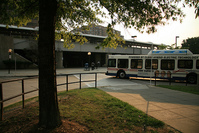Montgomery councilmembers: Get moving on bus priority

Photo by icantcu on Flickr.
Four members of the Montgomery County Council asked county officials to stop dragging their feet on bus priority, and implement or at least evaluate some fixes as soon as possible.
In a recent letter, they praise the Montgomery County Department of Transportation (MCDOT)‘s work on Ride On, but criticize its unwillingness to pursue bus priority in the short term.
They ask MCDOT to work with state officials and WMATA to find high priority intersections ripe for signal priority or queue jumper lanes that would help buses avoid delays in traffic.
WMATA has been promoting ideas around bus priority for a number of years now. Quite simply, buses spend a fair amount of time in traffic, and that time costs a lot of money. Some of the growth in operating costs comes from more time in traffic. If buses can move more efficiently, it saves on costs and also improves the bus ride for everyone.
Traditional traffic engineering measures intersections and roads based on numbers of vehicles. If changing a signal timing would let more vehicles traverse the intersection, classic traffic engineering says make the change. But we really should be counting people. If one bus has 50 people and a change would help it move faster than 20 cars, giving the bus priority is the right move.
Montgomery County’s DOT, notoriously one of the least progressive in the region, has been resistant to this thinking. When activists suggested a few intersections for signal timing, signal priority, or queue jumper lanes, MCDOT pooh-poohed them all but didn’t suggest any alternatives of their own.
At a recent county council hearing on transit, MCDOT officials said that any of these fixes would “have to wait” until the county implements a comprehensive Bus Rapid Transit system, like the one being pushed by Councilmember Marc Elrich.
The council disagrees. In a letter to MCDOT and WMATA officials, councilmembers Hans Riemer and Nancy Floreen (at-large), council president Valerie Ervin (district 5, Silver Spring/Takoma Park), and Transportation, Energy, Infrastructure & Environment committee chair Roger Berliner (district 1, Bethesda/Potomac/Chevy Chase) asked MCDOT in effect to get off its butt and start doing something.
They ask MCDOT, Maryland State Highway Administration, and WMATA to generate a list of the highest priority intersections for bus priority fixes, to evaluate the possibility of changes, release that information publicly in a way that residents can review, and to generate a policy to guide such changes.
Kudos to the council for stepping up on this issue. Montgomery County is often one of the most progressive counties on many policies, but its transportation officials need some prodding to pursue solutions beyond just focusing on moving cars. They should take this letter to heart and get their staff, and the buses, moving.
